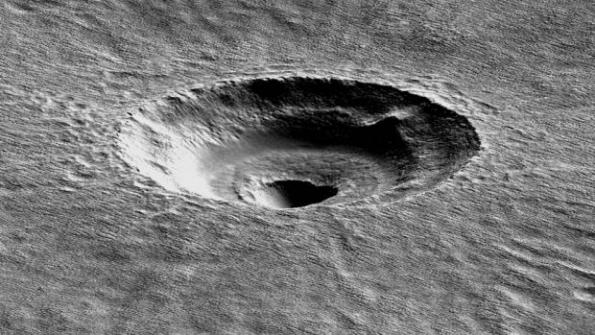Strange Crater Shape Leads to Enormous Mars Underground Ice Discovery

An oddly shaped crater on the mid latitudes of the Martian northern hemisphere likely obtained its terraced profile from a surprisingly large subsurface ice deposit -- estimated at the combined size of California and Texas and about 130 feet thick, according to researchers at the University of Arizona's Lunar and Planetary Laboratory.

Imagery and radar soundings of the Arcadia Planitia region gathered by NASA's 10-year-old Mars Reconnaissance Orbiter played a significant role in the discovery described by the researchers in the Aug. 26 edition of Geophysical Research Letters, a journal of the American Geophysical Union.
The aged, subterranean ice island likely formed during a past climate era on the now cold and dry red planet. Previously, ice deposits monitored from afar at the Martian poles offered clues of Mars' climate history. The discovery promises to add to the story.
"Knowing where the ice is and how thick it is can tell you about Mars' past climates," explains University of Arizona planetary scientist Shane Byrne in a statement.
"The fact that the ice is so thick and widespread leads us to think it came into place during one of Mars' past climates when it snowed a bunch, ice accumulated, was buried, and then preserved," said Byrne, who directs the university's Space Image Center. "There have been a lot of climate changes between now and the tens of millions of years ago when we suspect the ice was put there. But it shouldn't be stable today, and other past climates of ice instability in this region mean the ice should've sublimated away into the dry Martian atmosphere by now. So, that's what we need to investigate."
Badger crater's strange shape caught the attention of Ali Bramson, a University of Arizona graduate student. Bramson and her colleagues used imagery from MRO's HiRISE camera to model the terraced crater and others like it in the region. Soundings from MRO's SHARAD radar instrument allowed the researchers to probe the subsurface and characterize the ice deposit.
The presence of the ice layer explains why the crater is not bowl shaped like the typical depression left by an impact. Differences in the subsurface material cause the shock wave of the impact to propagate differently.
The researchers believe the large ice deposit and its present status has something to do with Martian obliquity, the degree to which the planet tilts on its axis. Without the gravitational pull of a relatively large moon, like the Earth's, Mars wobbles on its axis, producing dramatic climate shifts on timescales spanning hundreds of thousands to millions of years.